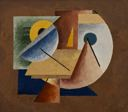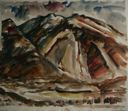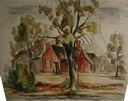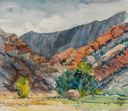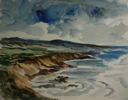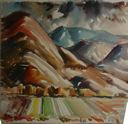George Smith Dibble does not have an image.
George Smith Dibble
(Oahu, Hawaii, 1904 - 1992, Salt Lake City, Utah)
George Dibble is a painter, teacher, and art critic who, throughout his career, greatly influenced numerous artists and students. He took his first art class through the mail from a Cleveland cartoonist and caricaturist. In 1926, he received his teaching certificate from the University of Utah and taught elementary school for two years. Dibble then returned to the University for additional classes in 1928. Although he previously had taken many art classes, he did not feel his learning began until he was in New York City studying at the Art Student's League. He stated, "I found my style at the Art Student's League. School was drudgery until I got to New York and realized I had a point of view, that I could use it and get recognition for it." In 1930, Dibble returned to Utah where he taught in the Murray School District. Then in 1935, Dibble continued his education at Columbia University, and in 1938, he received his Bachelor of Arts and in 1940, his Master of Arts from Columbia University. While at Columbia, Dibble was influenced by several artists and styles including Cezanne and cubism. Dibble said about cubism, "I found it quite interesting to me because I found that it was strengthening to organize the canvas in spatial terms, in terms of concept. The multiple viewing for example, understanding what's inside the cup as well as outside, was fascinating." After his graduation, Dibble taught at Utah State University as a visiting professor. Not long after, he accepted a job with the University of Utah's Stewart Training school where he trained teachers for the next seven years. The art faculty at the center implemented some of the most innovative educational ideas of the time. Dibble encouraged his students to explore and to find and follow their own direction, feeling that as a student, he had progressed best under such an approach. In 1949, he was promoted to associate professor at the University of Utah, and in 1950 became a visiting professor for summer sessions at the College of Southern Utah (now University of Southern Utah). In addition, he wrote a successful column for The Salt Lake Tribune for over 38 years. In the late 1930s, the Utah State Art Center exhibited works by Dibble and Bill Parkinson in what was probably the first non-objective art show in Salt Lake City. Dibble was a member of the first Modern Artists of Utah and participated in an exhibition and helped write a formal statement to the public, both intended to increase the understanding and acceptance of modern art in Utah. Although there was a group of Utah artists who had, as Dibble called it, " . . . the experimental urge ", there also was a powerful group of established artists who were appalled by the modernists. B. F. Larsen labeling the trend communistic and Avard Fairbanks publicly declaiming art was "going to the dogs." In fact, the only art chairman in Utah who was not opposed to modern influences was Calvin Fletcher, of Utah State University. Over the years, Utah has continued to have this division of representational, traditional artists and artists exploring the current, contemporary trends. George Dibble's Marine #2 was done in 1938 and exhibits the main features of a cubist painting. (Cubists attempt to depict an object as it is known, often portraying several different aspects of the object simultaneously using simplified, geometric shapes they establish an intellectual, rather than a visual "realism.") This painting refers to a seascape "in the most extreme sense." The painting is Dibble's visualization of the scene, ordered so the work is non-objective, the triangle of the sail the only recognizable part. Dibble maintained this painting was the most abstract work, to date, that was then being exhibited in Utah.
(Oahu, Hawaii, 1904 - 1992, Salt Lake City, Utah)
George Dibble is a painter, teacher, and art critic who, throughout his career, greatly influenced numerous artists and students. He took his first art class through the mail from a Cleveland cartoonist and caricaturist. In 1926, he received his teaching certificate from the University of Utah and taught elementary school for two years. Dibble then returned to the University for additional classes in 1928. Although he previously had taken many art classes, he did not feel his learning began until he was in New York City studying at the Art Student's League. He stated, "I found my style at the Art Student's League. School was drudgery until I got to New York and realized I had a point of view, that I could use it and get recognition for it." In 1930, Dibble returned to Utah where he taught in the Murray School District. Then in 1935, Dibble continued his education at Columbia University, and in 1938, he received his Bachelor of Arts and in 1940, his Master of Arts from Columbia University. While at Columbia, Dibble was influenced by several artists and styles including Cezanne and cubism. Dibble said about cubism, "I found it quite interesting to me because I found that it was strengthening to organize the canvas in spatial terms, in terms of concept. The multiple viewing for example, understanding what's inside the cup as well as outside, was fascinating." After his graduation, Dibble taught at Utah State University as a visiting professor. Not long after, he accepted a job with the University of Utah's Stewart Training school where he trained teachers for the next seven years. The art faculty at the center implemented some of the most innovative educational ideas of the time. Dibble encouraged his students to explore and to find and follow their own direction, feeling that as a student, he had progressed best under such an approach. In 1949, he was promoted to associate professor at the University of Utah, and in 1950 became a visiting professor for summer sessions at the College of Southern Utah (now University of Southern Utah). In addition, he wrote a successful column for The Salt Lake Tribune for over 38 years. In the late 1930s, the Utah State Art Center exhibited works by Dibble and Bill Parkinson in what was probably the first non-objective art show in Salt Lake City. Dibble was a member of the first Modern Artists of Utah and participated in an exhibition and helped write a formal statement to the public, both intended to increase the understanding and acceptance of modern art in Utah. Although there was a group of Utah artists who had, as Dibble called it, " . . . the experimental urge ", there also was a powerful group of established artists who were appalled by the modernists. B. F. Larsen labeling the trend communistic and Avard Fairbanks publicly declaiming art was "going to the dogs." In fact, the only art chairman in Utah who was not opposed to modern influences was Calvin Fletcher, of Utah State University. Over the years, Utah has continued to have this division of representational, traditional artists and artists exploring the current, contemporary trends. George Dibble's Marine #2 was done in 1938 and exhibits the main features of a cubist painting. (Cubists attempt to depict an object as it is known, often portraying several different aspects of the object simultaneously using simplified, geometric shapes they establish an intellectual, rather than a visual "realism.") This painting refers to a seascape "in the most extreme sense." The painting is Dibble's visualization of the scene, ordered so the work is non-objective, the triangle of the sail the only recognizable part. Dibble maintained this painting was the most abstract work, to date, that was then being exhibited in Utah.
Artist Objects
